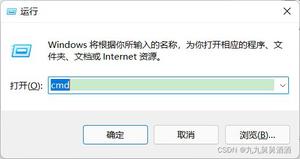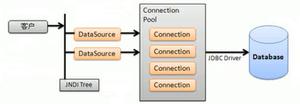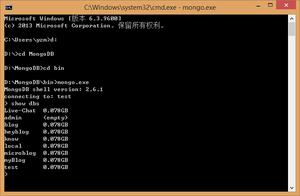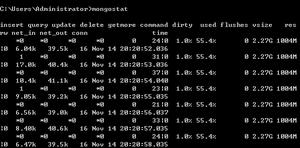Java如何连接到MongoDB数据库?
在上一篇文章中,您已经了解了我们如何安装MongoDB数据库服务器,并尝试使用MongoDB Shell来操纵数据库中的集合。还向您介绍了如何获取和设置MongoDB Java驱动程序,我们可以使用该驱动程序通过Java程序来操作MongoDB数据库。
从这篇文章开始,我们将开始探索更多有关如何使用MongoDB Java驱动程序与MongoDB一起使用的功能。您将看到我们如何连接到数据库,如何使用Java驱动程序执行CRUD操作(创建,读取,更新和删除)。但是首先让我们看看如何在MongoDB中创建与数据库的连接。
这是我们的第一个代码段,它向您展示如何引导MongoDB来打开与数据库的连接。
package org.nhooo.example.mongodb;import com.mongodb.*;
import java.net.UnknownHostException;
import java.util.Random;
public class MongoDBConnect {
public static void main(String[] args) {
try {
MongoClient client =
new MongoClient(new ServerAddress("localhost", 27017));
DB database = client.getDB("school");
DBCollection students = database.getCollection("students");
students.remove(new BasicDBObject());
String[] types = {"Homework", "Quiz", "Essay"};
for (int i = 1; i <= 10; i++) {
for (int j = 0; j < 3; j++) {
students.insert(new BasicDBObject("student_id", i)
.append("type", types[j])
.append("score", new Random().nextInt(100)));
}
}
try (DBCursor cursor = students.find()) {
while (cursor.hasNext()) {
System.out.println(cursor.next());
}
}
} catch (UnknownHostException e) {
e.printStackTrace();
}
}
}
您可以从上面的代码中看到。首先,我们通过创建的实例来引导MongoDB MongoClient。在这里,我们传递一个,ServerAddress以定义有关主机名和端口号的信息的MongoDB数据库的地址。如果您仅创建一个MongoClient不带任何参数的实例,它将使用默认地址(例如localhost主机)和27017默认端口号。创建的实例MongoClient可以产生UnknownHostException,因此我们需要将其放入try-catch语句中。
try { MongoClient client =
new MongoClient(new ServerAddress("localhost", 27017));
} catch (UnknownHostException e) {
e.printStackTrace();
}
初始化后,MongoClient我们可以通过调用getDB()方法并将数据库名称作为参数来连接到数据库。在上面的示例中,我们连接到school数据库,MongoDB中的数据库由包中的DB类表示com.mongodb。连接到数据库后的下一行,您可以看到我们正在students从该数据库获取集合。仅出于本示例的目的,我们然后students使用类的remove()方法清空集合DBCollection。
DB database = client.getDB("school");DBCollection students = database.getCollection("students");
students.remove(new BasicDBObject());
在接下来的几行中,直到代码片段的结尾,您可以看到我们将一些随机数据填充到students集合中。我们调用DBCollection.insert()将文档插入students集合中的方法。最后,我们students使用find()方法从集合中读取插入的文档,并逐一迭代返回的游标,直到所有文档打印在控制台上。您还可以看到,由于该代码DBCursor已经实现了Java 7 AutoCloseable接口,因此在此代码中使用了try-with-resource语法。
String[] types = {"Homework", "Quiz", "Essay"};for (int i = 1; i <= 10; i++) {
for (int j = 0; j < 3; j++) {
students.insert(new BasicDBObject("student_id", i)
.append("type", types[j])
.append("score", new Random().nextInt(100)));
}
}
try (DBCursor cursor = students.find()) {
while (cursor.hasNext()) {
System.out.println(cursor.next());
}
}
这是上面我们的代码产生的结果的样本。
{ "_id" : { "$oid" : "53f47814f524c5037606f2b4"} , "student_id" : 1 , "type" : "Homework" , "score" : 86}{ "_id" : { "$oid" : "53f47814f524c5037606f2b5"} , "student_id" : 1 , "type" : "Quiz" , "score" : 14}
{ "_id" : { "$oid" : "53f47814f524c5037606f2b6"} , "student_id" : 1 , "type" : "Essay" , "score" : 35}
{ "_id" : { "$oid" : "53f47814f524c5037606f2b7"} , "student_id" : 2 , "type" : "Homework" , "score" : 12}
{ "_id" : { "$oid" : "53f47814f524c5037606f2b8"} , "student_id" : 2 , "type" : "Quiz" , "score" : 96}
{ "_id" : { "$oid" : "53f47814f524c5037606f2b9"} , "student_id" : 2 , "type" : "Essay" , "score" : 51}
{ "_id" : { "$oid" : "53f47814f524c5037606f2ba"} , "student_id" : 3 , "type" : "Homework" , "score" : 54}
{ "_id" : { "$oid" : "53f47814f524c5037606f2bb"} , "student_id" : 3 , "type" : "Quiz" , "score" : 50}
{ "_id" : { "$oid" : "53f47814f524c5037606f2bc"} , "student_id" : 3 , "type" : "Essay" , "score" : 38}
{ "_id" : { "$oid" : "53f47814f524c5037606f2bd"} , "student_id" : 4 , "type" : "Homework" , "score" : 69}
以上是 Java如何连接到MongoDB数据库? 的全部内容, 来源链接: utcz.com/z/321397.html









